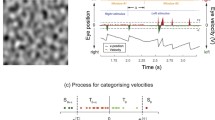Summary
The cumulogram (graphic representation of the cumulative eye position) seems to be a reliable method for studying intensity, symmetry, and regularity of nystagmic responses.
Applying sinusoidal rotatory stimulation, the vestibular output can be described in terms of gain and phase difference. The numerical evaluation of cumulograms is demonstrated for sinusoidal tests. The dependence of age is determined for gain and phase difference. While the phase difference appears to be practically independent, the gain of the vestibulo-oculomotor system is strongly correlated with age.
Similar content being viewed by others
Literatur
Allum, J. H. H., Tole, J. R., Weiss, A. D.: MITNYS-II — a digital program for on-line analysis of nystagmus. IEEE Trans. Biomed. Eng. 22, 196–202 (1975)
Anzaldi, E., Boselli, A., Mira, E., Schmid, R-, Stefanelli, M.: Slow and fast cumulative eye positions in vestibular nystagmus. X. World Congress of Oto-rhinolaryngology, Venice, 1973
Baarsma, E. A., Collewijn, H.: Changes in compensatory eye movements after unilateral labyrinthectomy in the rabbit. Arch. Otorhinolaryngol. 211, 219–230 (1975)
Causse, J.-B.: Le tracé cumulé de la phase lente du nystagmus vestibulaire. Réalisation d'un cucumulomètre analogique. Étude statistique des cumulogrammes du sujet normal. Thèse, Strasbourg, 1975
Henriksson, N. G.: The correlation between the speed of the eye in the slow phase of nystagmus and vestibular stimulus. Acta Otolaryngol. (Stockh.) 45, 120–136 (1955)
Jongkees, L. B. W., Philipszoon, A. J.: Electronystagmography. Acta Otolaryngol. (Suppl.) (Stockh.) 189, 1–111 (1964)
Mira, E., Schmid, R., Stefanelli, M.: Application clinique d'un modèle mathématique de système vestibulo-oculomoteur. Acta Otorhinolaryngol. Belg. 29, 29–55 (1975)
Moser, M., Ranacher, G.: Klinische Ergebnisse der quantitativen Nystagmusanalyse. Arbeitstagung ADANO, Bonn, 1978
Ranacher, G.: Nystagmusvergleich bei der thermischen Labyrinthstimulation. Laryngol. Rhinol. Otol. (Stuttg.) 56, 372–375 (1977)
Ranacher, G.: Nystagmusauswertung am Computer. Arch. Otorhinolaryngol. 215, 257–263 (1977)
Ranacher, G., Moser, M.: Datenverarbeitung in der Elektronystagmographie. Arch. Otorhinolaryngol. 211, 93–104 (1975)
Ranacher, G., Moser, M.: Quantitative Nystagmusanalyse am Digitalrechner. Arbeitstagung ADANO, Bonn, 1978
Rapp, B., Montandon, A., Hausler, R.: Sommation automatique des phases lentes du nystagmus en pathologie vestibulaire. Acta Otorhinolaryngol. Belg. 29, 153–162 (1975)
Tole, J. R., Young, R.: MITNYS. A hybrid program for on-line analysis of nystagmus. Aerospace Med. 42, 508–511 (1971)
Author information
Authors and Affiliations
Additional information
Mit Unterstützung der Stadt Graz und des Fonds zur Förderung der wissenschaftlichen Forschung, Projekt Nr. 2976
Rights and permissions
About this article
Cite this article
Ranacher, G. Das Kumulogramm der Pendelprüfung. Arch Otorhinolaryngol 222, 53–61 (1979). https://doi.org/10.1007/BF00456339
Received:
Accepted:
Issue Date:
DOI: https://doi.org/10.1007/BF00456339




